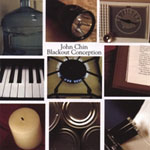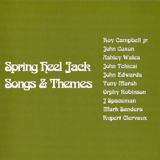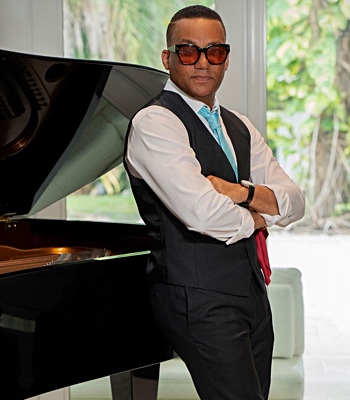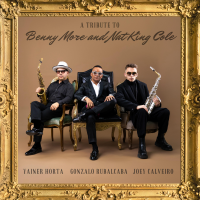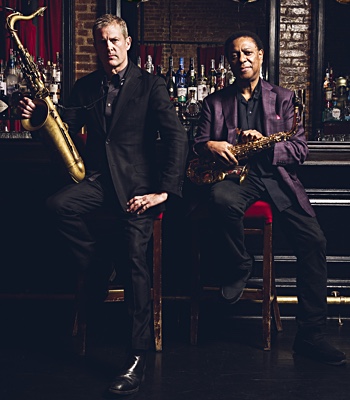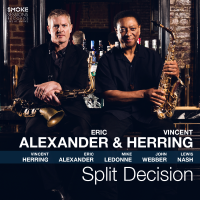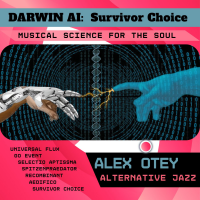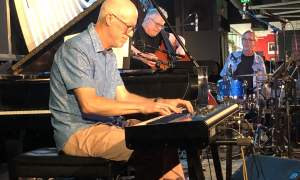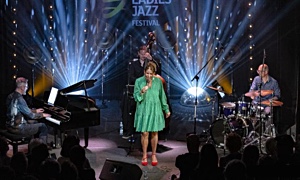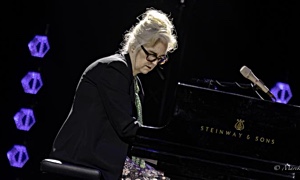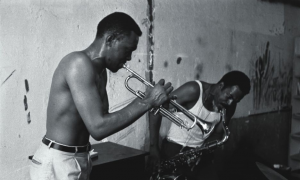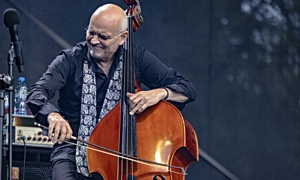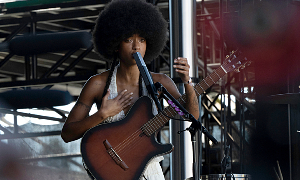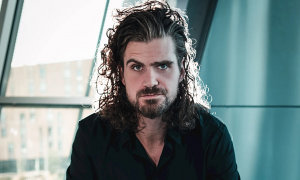Home » Jazz Articles » Back Roads Beat » The World's Northernmost Jazz Festival: Polarjazz 2008 i...
The World's Northernmost Jazz Festival: Polarjazz 2008 in Longyearbyen, Norway
The place remained completely jammed with people standing all the way to the lobby as the Urban Tunells Klezmer Band took the stage just before midnight. Billing themselves as one of the few such Norwegian bands, the quintet promotes itself as respecting Klezmar's traditions while touching on modern deconstructions into Jewish jazz, hip-hop and "klezcore" made popular by groups such as Balkan Beat Box. Urban Tunells' set came nowhere near BBB's club-beat intensity, although some of that can be heard on their 2007 album Upnorth Balkan Beats—The Kohib Remixes (10 MP3s from this and their other albums are at their Web site). Instead the performance was free and frenetic in a more acoustic roots vein and, while personally a fan of both groups, this was probably a better listening experience for those seeking more than immediate gratitude.
The opening was a deceptive bit of plodding melancholy by pianist/vocalist Tor-Petter Aanes, whose deep coaxing voice reminded me for some reason of Brazilian stalwart Joao Bosco. There wasn't a lot of time for reflection, however, as with a heavy vibrato flourish the rest of the band leaped in with a series of instrument shots and overlapping quips. Clarinetist Morten Michelsen fired off a succession of rapid Klezmer vamps punctuated by some sustained high screams, brought it back down to the dirge, then accelerated back up to the expected fast finish. Accordionist Jovan Pavlovic displayed intense jazz chops a couple of songs later with a thick, atonal barrage against a simple pounding cadence, which Morten wrapped up with a series of screams that broke down into rapid-fire snippets. Double bassist Sondre Meisfjord's most memorable moment came a song later by going on a multitude of short-term, sparse-note journeys from a common starting point. Drummer Stig Rennestraum's work escaped scrutiny in my notes, but I did pen something about there being a lot more "movers"—plus some actual dancers—compared to the two earlier shows.
The Ultimate All-Night Party
When night lasts four months, staying up until 7 a.m. is nothing.The final full day of Polarjazz concerts went way late, but that didn't deter most of the participants. The final concert, a salsa dance party, was full despite starting more than an hour after its scheduled 12:30 a.m. time, and musicians from various bands followed up with a jam session until nearly 4 a.m.
"Everybody went after that to a party," Hansen said.
I'll take the director's word for it, since my endurance has a more mortal limit.
That limit manifested itself in the worst possible way when a mid-morning nap lasted until mid-afternoon, causing me to miss a concert by pianist Anders Aarum's quartet at the university. His albums (five MySpace songs) are the quintessential example of scholarly modernism that characterizes the best Scandinavian jazz musicians, possessing a style people more informed than me call an individual voice evolved a few generations from McCoy Tyner. Aarum's three albums explore everything from spare acoustic poetry to electric funk and none of it smacks of artistic compromise.
While seriously bummed, I found out later not all was lost. But I had to subcontract the afternoon review to Peter, the Australian tourist checking out the winter scene after his summer visit.
"It was a mixed bag, but I enjoyed quite a lot of it," he said. It was "more the ruckus" side of mainstream in the vein of John Coltrane, thanks to Aarum playing an electric keyboard (safer from a tuning perspective), two guest vocalists and some dominant work by saxophonist Gisle Johansen (name is my guess, based on who Aarum's been playing with at recent festivals).
The trio of evening concerts started with vocalist Kari Bremnes, apparently known as the "voice of northern Norway," who managed to attract a bigger crowd than the already beyond-capacity masses who'd squeezed sardine-like into some previous shows. The reason quickly became obvious, as she put on a loud, showy Norse rock/pop tour with a lot of shifting themes and beats ("call this a moneymaker show," I noted). Songs transformed from slow folksy ambiance to well-known dance beats to blues guitar solos to drumwork on truck tire rims or emulating Latin hand percussion on a standard kit. Her voice, in the low mid-range, almost always seemed to be trying to seduce regardless of setting. As Joe put it, she sounded like a Norwegian Enya.
"She was a really good vocalist, but there wasn't a musicianship," he said. At times the band's strategy seemed to be "if you make a mistake play it repeatedly and the audience will think you're doing it on purpose."
I'm willing to call it an off night since Bremnes' 2007 Live album (sound samples at official site) and others I've heard from her 20-year career are considerably more refined.
The next act offered some redemption for my midday slumber.
Oslo singer Julie Dahle Aagaard's horn-heavy band was more interesting than Bremnes from a jazz perspective and featured Aarum on a rack of keyboards. Doing a set of originals and covers ranging from ballads to funk, her husky voice reminded me of Alanis Morissette, although she lists Donny Hathaway, Stevie Wonder, Lenny Kravitz and Angie Stone among her influences. Her band got plenty of solos, usually quality fusion stuff, although Aarum didn't quite fulfill hopes due in part to sound problems that also constantly made Aagaard's vocals hard to discern.
Aagaard's saxophonist (Gisle Johansen if her MySpace bio is current) stood out most consistently in quantity and quality, blowing modestly challenging but energetic streams of on-key runs and trills on alto and tenor. Guitarist Nils-Olav Johansen (Web site and free MP3 downloads) also was a frequent presence, rolling out more delicate soft-tone notes in a similar harmonizing vein. He also replace Aagaard as the lead vocalist on two songs and was, in a word, awful. Poor volume and pitch control made the audio problems Aagaard experienced even worse and, while his resume describes exotic influences such as Hawaiian and Balkan music, on the Polarjazz stage he was playing the pop dreck one hears from tired cruise ship veterans. The only redeeming aspects were some wordless harmonizing in collaboration with his guitar and stretching out on instrumental solos, opening "Out Of Nowhere" with a soothing sequence of dual note/chord lines and later walking a path of intelligent musings with constant detours into bright embellishments.
Aagaard returned for the final four songs, but some of the energy—and a noticeable portion of the crowd—was gone. A couple of rock/gospel numbers revived memories of some earlier horn section highlights, but two well-known standards, "For All We Know" and the encore "What's Going On," fell flat. The former plodded along at a slower pace than normal with minimal electric keyboard accompaniment and lacked enough emotional authenticity to warrant the pace. The latter was simply a poor match for her vocal talents, a regrettable ending since it was the one song I considered her delivery substandard.
The thinner crowd was something of a blessing for volunteers (many recruited on the spot) who cleared the chairs for the Mambo Companeros. The band's eight members, six freelance Trondheim musicians and two Cubans living in Oslo, write a large portion of the music they perform and is as authentically Afro/Cuban as any band the untrained ear might hear. I can tell you they played enthusiastically, were more listenable than a lot of similar bands that play too loud for their audio rigs, there was a full dance floor at nearly 2 a.m.—and it utterly failed to connect with me in the way that vegans' pallets clash with fois gras. I'm into elements of such music blended with mainstream, be it Michel Camilo or certain Paquito D'Rivera albums. I can't explain the disconnect with the real thing, other than I was staggeringly bad when I took some classes with Kristan several years ago and recoil in terror at the nonstop urging from everybody to dance.
So I bailed on the revelers, the jam of standards involving what I hear was a strong plurality of the festival's lineup and the party until the false dawn that began the few hours of twilight that day. But ultimately I outlasted many of those hardy souls in the final round of endurance.
A Divine Finale
A lot of people left town Sunday and the sparse schedule looked like something of an afterthought: a bargain-priced 5 p.m. performance at the local church featuring the children's choir and some vocalist. Experience indicates such shows typically have little musical value beyond cuteness and gratification for parents.I should have had more faith.
Randi Tytingvaag's quartet joined the stage after two songs by the choir and pulled off the rare feat of playing a set of jazz appealing to all ages. Compositions were full of playful quips, melodramatic exclamations and quick-hook themes kids might associate with the heroine's theme song of a Disney movie or the quavering atonality of twisted holiday specials. But stuff for grown-ups kept popping to the surface via uncompromising solos and complex improvised unspoken dialogue between Tytingvaag and/or her acoustic piano/bass/accordion mates. It revived memories of those classic inside jokes from the original Sesame Street (The Count: "They call me the Count because I love to count things." Guy Smiley's response: "Well, I'm Guy Smiley. They call me Guy Smiley because I changed my name from Bernie Liederkrantz." The episodes are now sold as "adults-only" DVDs, by the way, thanks to characters like a bulimic cookie freak, closed gay couple and a Snuffleupagus who apparently was just a bird's trippy hallucination).
Getting back to the band, did I mention Tytingvaag's pianist is Aarum, appearing yet again in the way musicians in small circles and communities are apt to do? Playing in a setting more suited for showing off his talent than Aagaard, I finally felt redeemed for my sloth.
Just getting there requires extra effort since Svalbard Church, a red mini cathedral, is semi-isolated on a barren hillside about half-mile from the center of town (putting it near the Huset's massive wine cellar). It has a cheery rather than somber character, with a fireplace, secular magazines and newspapers to read in the cozy common room chairs, and a communal dinner of Norwegian waffles on Tuesdays. On this day, big platters of cured meats and huge bowls of sour cream porridge known as roemmegroet were served an hour before the concert as part of the 100 krone (roughly $18) admission that was a separate fundraiser from the festival. As someone who's dietary restrictions involves eating so much oatmeal I can distinguish brands the way those with perfect pitch can transcribe recordings, I consider the filling simplicity of this Norwegian peasant dish—suitable for sweet or savory stir-ins —among the world's best.
Parents and other adults filled the pews and then some, as plenty of chairs in the adjacent common room remained occupied, so kids not on stage took all the free space in the center aisle. A profusion of cameras and camcorders captured the 25-member choir as they sang an opening song in Norwegian and "This Little Light Of Mine" in alternating English/Norwegian. They were like any well-rehersed such group, with their sheer numbers smoothing out perceptible imperfections. A couple performed solo verses and, while short of prodigy-like, there wasn't the hesitant shyness from them or the others commonly heard from those elsewhere of similar talent.
"They have fun and they are safe with each other, so they are free to sing out," said Tore Oerjasaeter, the choir's director for the past year and a half.
Tytingvaag's band joined the kids for something bouncy and simple, Aarum giving little hint of what was to come with a simple harmonious minute-long solo. After the kids departed, accordionist Espen Leite launched into a thick and melancholy melody in a simplistic quarter-note march to open "Rat Race." Tytingvaag's alto lyrics rang richly through the despite the primitive acoustics, conveying the mood of a cartoon heroine in her moment of despair. Leite and Aarum soloed through a series of spiraling downward progressions, accented with some freeform bursts, and embellished well off Tytingvaag's lines. The succeeding "Ghost" featured an ascending audio profile of the heroine finding hope and/or courage, apparently regarding something she wants to be when she grows up. The character and plot weren't suggested by the musicians, incidentally, but the progression of themes made constructing one in my head easy enough.
The mental storylines weren't G-rated as Tytingvaag's band didn't just give the kids fluff, frequently exploring dark and chromatic themes. A quavering accordion on "Everyday Monsters" bore great resemblance to "The Nightmare Before Christmas," including some lyrics about a character named Jack. The lyrics of "War" could describe the daily life of Anne Frank, and Leite's and Aarum's freeform interlude on "So Long" bore whiffs of an late-night acoustic acid basement gig. A tugging of moods was constant, as songs like "Between Us" strived for hope in meeting challenges ("have you ever considered going for a swim in the ocean between us").
The choir joined for a cheerful finale whose name and lyrics escaped me and, while it was intended to speak more directly to the kids in the audience, a lot had strayed from their seats on the floor to the less restrictive possibilities of the common room. If there was a weakness from the youths' perspective, it was the lack of material encouraging them to be directly involved through singing, clapping, dancing or whatever. But it's the show I'd take my (hypothetical) kid to, in the same way other parents play those "Baby Einstein" tapes in the hope their offspring will someday become members of Mensa.
Oerjasaeter said he has no doubt about the children's musical commitment.
"We have a solid group," he said. "They come every time, unlike some other places."
He said they rehearse once a week, perform once a month during family services and participate in about a half-dozen special events such as Constitution Day in May. The choir recorded a CD—largely common children's songs rewritten with Norwegian lyrics—under a different director years ago that's sold locally (outsiders might be able to buy a copy by e-mailing the church at [email protected]), but Oerjasaeter said no future such projects are on the horizon.
Oerjasaeter, a self-taught pianist, said he worried about being good enough to direct the choir, but his work with groups while living in Oslo about a decade ago "was good enough because this is a special place to live, so sometimes you have to improvise."
Among the challenges, he said, is the constantly fluctuating population. "Last year we had 11, so (this year) was a big growth," he said.
Oerjasaeter said the lure of overcoming his personal challenges ("Will I be able to work with people? Will I be able to enjoy the dark season?") brought him to Longyearbyen. He said he doesn't know his long-term plans, but even after a long winter he has no regrets.
"The snow and the light, it's beautiful, but it's the people that keep it going," he said.
Tags
Comments
PREVIOUS / NEXT
Support All About Jazz
 All About Jazz has been a pillar of jazz since 1995, championing it as an art form and, more importantly, supporting the musicians who make it. Our enduring commitment has made "AAJ" one of the most culturally important websites of its kind, read by hundreds of thousands of fans, musicians and industry figures every month.
All About Jazz has been a pillar of jazz since 1995, championing it as an art form and, more importantly, supporting the musicians who make it. Our enduring commitment has made "AAJ" one of the most culturally important websites of its kind, read by hundreds of thousands of fans, musicians and industry figures every month.


